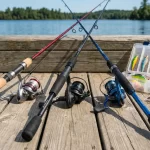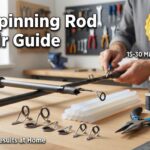What’s better for your fishing trip, a spinning rod or a casting rod?
You want to land that big catch and enjoy quality time outdoors with friends. You like trying different techniques because it makes the experience more exciting.
But you are not sure which type of equipment is best suited for your fishing skills, whether one will give you an edge over others when fighting fish or make a mess in the process and lose gear.
Using the wrong tool could result in missing out on that “big catch” experience. The thought alone can be frustrating – all because of something as simple yet crucial as choosing between two fishing rods.
This is why we have written an article to explore which rod reigns supreme, providing you with the knowledge and information needed so you don’t miss out on that dream catch.
You’ll get hands-on tips for picking up either a spinning or casting rod depending upon what type of fishing environment your are in.
Spinning Rod Advantages and Limitations

Spinning rods have been used by anglers for decades, but do they really offer benefits over casting rods?
Some experts believe spinning rods are ideal in situations where you want a fast action to catch fish. This can be especially true when fishing small waters like ponds or lakes.
A key reason is that the tip of the rod acts as a fulcrum, allowing for more flexibility and sensitivity which helps land bigger catches.
When it comes to using spinning gear, you’ll notice your hook setting response time has improved because the action allows fast strikes and instant fight. This can be very effective when reeling in fish like trout or bass.
But there are limitations where casting rods may prove to be a better option. A good example of this is fishing for large saltwater species, especially big game fish.
Some of Recommended Spinning rods Tested by My Team
Casting Rod Benefits and Drawbacks
Casting rods have been a long-standing favorite among anglers, especially those targeting larger fish like bass or pike. The traditional casting rod has its loyal fan base for good reason.
Sensitivity:
- Better suited to catch subtle movements of the bait
- Aids in identifying the strike and hook setting
Action and Feel:
- Allows a more natural action, which helps to engage bigger fish.
- Can make it easier to feel even light bites.
Some of Recommended Casting rods Tested by My Team
Choosing a Fishing Location for Your Preferred Technique
When it comes down to choosing between spinning or casting, you should take into account what kind of location your preferred technique can work best in.
Casting is often considered a more powerful rod because its motion allows for long-distance casts. This makes it ideal for fishing locations with longer stretches of water like rivers and lakes.
For example, casting works well on the open waters where fish are spread out. The technique also excels when you’re using bait to target larger game such as bass or pike.
On the other hand, spinning is a more versatile option because its faster retrieval rate makes it easier for smaller areas like small ponds and streams.
For instance, in places where fish are close together, spinning performs well. The technique also works better when using lure to catch smaller species such as trout or panfish.
Comparing Reel Types: What’s Right for You?
The age-old debate in angling circles centers on which tool reigns supreme, spinning or casting rods. This article aims to break down the key differences between these two popular options.
Choosing Between Rod Types:
- Anglers who prefer a more laid-back experience will lean towards spinners.
- For those seeking versatility and variety, casters are the better choice.
Key Features to Consider:
- Spinning rods: great for beginners due to their ease of use; suitable for light line fishing (4-10 lbs).
- Casting rods: more popular among experienced anglers, ideal for heavier lines (12-20 lb).
Line, Bait, or Lure – A Consideration of Equipment Essentials
When it comes down to choosing between spin rods and casting rods for your fishing needs.
There are a number of factors you need to consider when deciding which one will best serve your purposes. The type of fish you’re after is perhaps the most important factor.
For example, if you’re after species like trout or smallmouth bass that fight with ease and can easily be caught on bait or lures, a spin rod may be more suitable.
The length and lightness of these rods make them easy to maneuver in close proximity. While this is not the case for larger fish like cod which are best targeted with casting.
The type of fishing you do plays a crucial role as well when it comes to choosing between spin or cast.
Conclusion: Which is Better? That Depends on You.
The waters have been muddied, and we’ve heard from both sides of a long-standing debate. Now it’s your turn to take what you’ve learned today out for a spin.
At its heart, this choice is never about choosing between two fishing rods because one method might be marginally faster than another; instead it is fundamentally an evaluation that seeks in depth understanding of which tool aligns with how and when. As our research has shown – your line will only get as sharp as you are.
By now, you may have a better grasp on what to use depending upon where we’re going fishing: from small breaming streams to massive game-fishing trips in remote areas of the world.
What this means is that it’s never an all or nothing situation. In fact most people can find ways for using either rod.
Which method do you use and when? Do your friends have different preferences?
Share your own personal experiences, tips and stories in the comments below so everyone may benefit from them.
You may also like 📖
-
10 Best Spinning Reel for Trout in 2023 (Buying Guide Review)
-
10 Best Saltwater Spinning Reels Under $100 – Ultimate Guide
-
10 Best River Trout Fishing Rods For 2023 Season: Expert Buying Guide
-
Can Baitcasters Improve Casting Accuracy More Than Spinning Rods?
-
What Length Spinning Rods Do You Need: (Finding the Perfect Fit)
-
How to Spool a Spinning Reel Like a Pro – Conquer Line Twist and Cast Like a Champion























